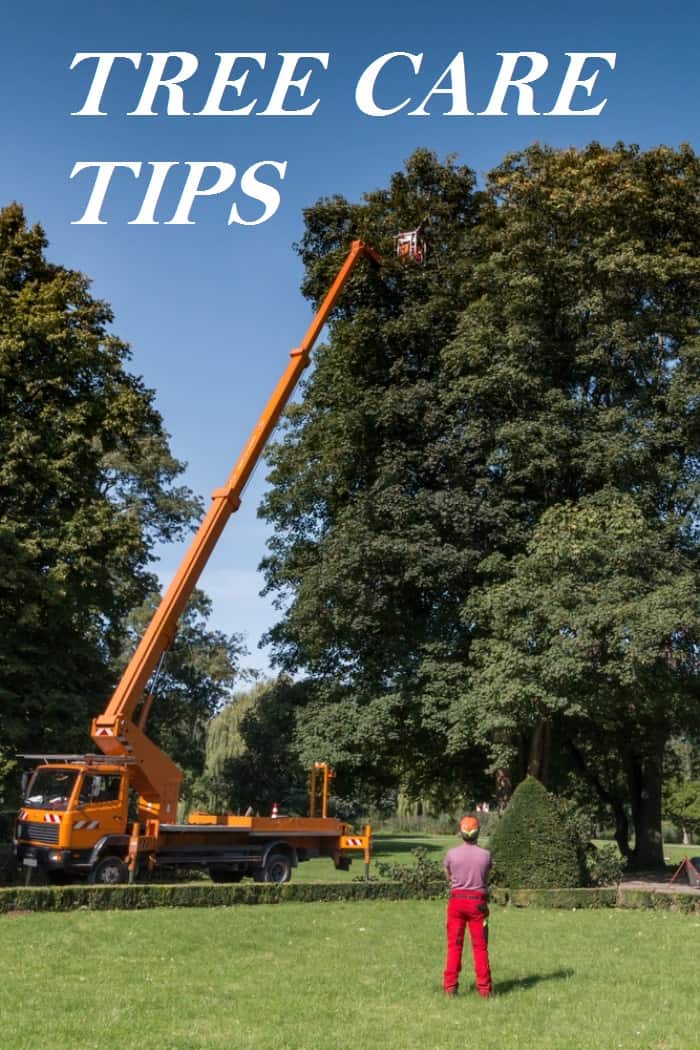
When it comes to having an amazing yard, beautiful trees are the best way to add depth and elegance to your landscaping. They can give your home stunning aesthetic as well as functionally help provide shade. However, it’s often too easy for homeowners to neglect the care of their older, more mature trees since they don’t need anywhere near as much care as younger, developing trees do. Unfortunately, this can be a serious mistake.
Making sure they stay in good health is a great way to invest in the long-term look of your landscaping. Even the strongest trees are susceptible to rot, decay, and disease. But what can you really do to ensure your trees are always at their best health? Here are a few tips for you to keep in mind that will help you care for your trees, both young and old.
15 Cutting Edge Tree Care Tips
- Get to Know Your Trees
Every type of tree needs a different level of care. By making sure you’ve done all the necessary research to ensure you’re giving your trees the right level of care, you can rest assured that they’re already off to a great start health-wise. There are multiple things you’ll want to ensure you look out for. To start, what type of soil does your tree prefer? This can play a big role in deciding which type you want to place around your home. How much water does your tree need? Does your tree have any particular sensitivities, whether to sun, high winds, or other plants? By making sure you’re avoiding placing trees in areas with these particular characteristics, you’ll be doing quite a lot to keep them on a healthy and happy path.
On the other hand, if you’re dealing with older trees that have already been established in a certain space, and you aren’t even sure what type of tree it is, the first thing you can do is take advantage of local professionals who can help you identify the family of tree you have, as well as make recommendations as to its continued care.
- Protect Tree Bark
All too often the bark of tree goes underappreciated and disregarded when it comes to a trees health. It’s often pulled away and used as reminders or toys for young children, but bark is a living armor that’s been wrapped around your tree, and it’s there for a reason. But forceful removal and bacterial infections can lead to serious problems if not attended to quickly. Some ways you can protect your trees bark include making sure it isn’t being constantly hit with a sprinkler, keep vehicles and lawn equipment at a safe distance, and make sure to tie up branches that seem to be intertwining as this can cause rubbing, which will quickly cause the bark to decay.
- Be Aware of Your Climate
If your trees are given the right nurturing and care, they will develop healthily, but the weather can have a serious impact on their well-being, no matter what stage of growth they’re at. It’s incredibly important that you stay aware of your climate as well as current weather patterns, which can change dramatically and have a serious impact on your entire landscaping, but especially your more mature trees. If you’re in an extended drought, make sure you remember to give substantial amounts of water to your trees as well as your other plant life as they won’t be able to get much of anything from the ground around them.
On the other hand, if it’s the winter and you live in a cooler area, make sure you don’t water at all, since this is a dormant season and they’ll have already gotten all the water they’ll need. Unless they’ve been recently moved or planted, trees need very little care in cooler winter months.
- Get Rid of Dead or Broken Branches
Losing branches is a completely normal process for any growing trees. However, making sure you prune your trees properly can make all the difference. Give your branches a clean cut in order to ensure self healing and new growth. If a branch snaps, it can lead to uneven edges, which can collect water and bacterias which will eventually lead to rot.
- Plant Ground Covers
By adding ground covers such as grass and other tiny plants around your tree, you’ll be helping to ensure that a wide range of nutrients will fall into the soil, making it a much better environment for your tree to be living in and allowing it absorb all those nutrients with its roots. Smaller, shade-loving plants can act like a living mulch that you won’t have to worry about replacing constantly.
Additionally, these smaller plants and grasses also help give your landscaping a more complete and appealing look. They will act as a benefit for both, almost like a win/win situation.
- Educate Yourself about Diseases
By becoming more and more familiar with the different diseases that can affect your trees, you’ll be more aware of when you see a potential sign, and will be able to act quickly. If you see progressive discoloration or odd growths, for example, you should call a professional arborist for an assessment immediately. These professionals will know exactly what course of treatment, if any, can be provided to restore your tree back to its original state of health.
- Get Rid of Weeds
While you might think that the tiny weeds around your massive tree couldn’t possibly cause any harm, this is the wrong way to think. Even the smallest of weeds absorb an unbelievable amount of water, making them serious threats for trees of any age. Making sure you get rid of all the weeds in the area will be key to keeping your tree in its best health.
- Understanding Vines
While it may seem like the complete opposite, not all vines are harmful to trees. Poison Ivy, for example, can actually be beneficial to local wildlife and won’t do anything to your trees. If there’s no cause for concern regarding issues with coming into contact with your skin or that of people you love, then you shouldn’t worry yourself about removing it.
On the other hand, most all other vines can be extremely detrimental and cause rotting and decay. However, pulling vines can damage the bark and leave your tree exposed to dangerous bacterias. It’s best to cut out six-inch slots of the vine, remove the root, and let it die on its own. Eventually they will fall off, which is a much safer solution for your tree’s health.
- Protect from Deer
While you might think that the cute little creatures are adorable prancing through your yard, they can actually cause extreme damage to trees at any stage of their lives. New trees can have buds or entire stems eaten up, causing irreparable damage. Older trees will be in danger of having young bucks rub their antlers along the bark, which of course provides relief for them, but will be extremely dangerous for the trees. Adding wire or netting around the trunks of your trees is a great way to deter deer from approaching and can easily be removed when necessary.
- Keep an Eye Out for Invasive Species
If you’ve recently started noticing a new plant type in your yard that you don’t remember putting there, then do some research to make sure it isn’t a new invasive species, which could be extremely harmful to your landscaping in general, including your trees. These new species are often not susceptible to local bacterias or parasites, and without these natural predators, they will grow and grow exponentially until they’ve wiped out most other local plant life. Don’t put your trees at risk of being overrun. Instead, simply remove any invasive species you come across.
- Invest in a Good Fertilizer
While you might think of fertilizer as being most important for freshly-planted flowers or in vegetable gardens, trees of all ages can greatly benefit from these added nutrients all year round. While providing fertilizers for newer trees is the most essential, making sure your older trees get a little, especially in the spring and summer months when growth is most profound, is key to ensuring healthy and beautiful trees for many years to come. While organic fertilizers are the best and healthiest option, they can take a longer time to give you the results you’re looking for. If you can’t afford to wait, finding an inorganic fertilizer with the proper nitrogen, phosphorus, and potassium ratio for your particular tree type will be key.
- Taking Care of Ice
If you have more brittle tree species like maples, birches, or willows, then the amount of damage which can occur from ice and winter storms can be devastating. These trees just don’t have the strength to be able to handle the weight and pressure from this type of weather. If you expect stronger winter storms, make sure you wrap your trees properly to keep ice from forming around the tips of limbs. Also, if you’re expecting a bad winter from the beginning, make sure you’ve done heavy pruning to ensure new growth can begin once the spring hits. Don’t risk losing older limbs for nothing.
- Do Not Stake Older Trees
All too often, homeowners believe that staking a tree will help maintain its form. However, what you’re really doing is limiting your trees growth rate and stunting it. While younger trees may need stakes to protect their trunks from damage and allow their roots to firm up, they should be removed after a year or two, and trees older than four years should never be staked, regardless of their shape or trunk width.
- Be Aware of Surroundings
While the tree you’re planting may seem cute next to your patio now, in a few years it can become a serious hazard to your home. Make sure that when planting trees you keep in mind the size and shape they will grow to in a few years, rather than where they look best in the moment. All too often homeowners decide to plant a tree based on their current size, or maybe a little larger, but fail to take into account growth rate and eventual size. Don’t plant a tree where you’ll eventually have to remove it, or worse, cut it down completely. Make sure you’ve taken the time to consider all factors when deciding which tree and where to plant it.
- Avoid Incompatible Neighbors
Research is the most important thing any tree owner can do to ensure its health. Different trees are compatible with different plants, and placing your trees next to their natural neighbors can have devastating effects. Oaks and Cypress, for example, will never be able to maintain a healthy relationship and thus should never be placed in proximity of one another. Regardless of the age of the trees you’re planting, these relationships are part of their nature and cannot be undone. Don’t make the mistake of putting competing species near one another and eventually losing the weaker of the two. Do all necessary research and keep all your plant life happy by placing them in areas where they can thrive.
Caring for the trees that make up the bulk of your landscaping can sometimes seem overwhelming. Many homeowners don’t even consider caring for their older trees since they’ve already been around for so long, which can be a devastating mistake. Trees of all ages need care and consideration in order to stay at their best. With the right amount of research and care taken, you can guarantee you’ll have beautiful, healthy trees for many years to come. Keep these aforementioned tips in mind so that you can be on your way to having the best-looking landscaping around. With the right amount of dedication, you can turn yourself into a tree expert today.
